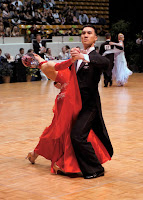At the end of the pandemic, maybe a new start? Look around, if you have been around and experienced tango communities come and go, you will see the effects of the
Dark Side, the negative elements of tango. Slowly tango can become extinct here and there in the tango world. Maybe a new start can help tango to better thrive?
Tango communities--communities that hug--will certainly lose some dancers forever and have a smaller pool of prospective dancers.
The Dark Side, then, is a true threat to tango communities as it is so vulnerable for viability now. It is true that a certain kind of tango may continue; I call it "Wax Museum Tango." You already are aware of the Wax Museum of Dance museum piece, taught with other ballroom dances which live in the Wax Museum of Dance, or the so-called ballroom dance. Although I have enjoyed ballroom dance, it really is not so much a social dance but for the show--expensive gowns and lessons which only the rich can afford.
You also have seen Wax Museum Tango exists already in the ballroom repertoire. It's a generalized rhythm taken from a few authentic but not beloved tangos. The ballroom tango tempo is prescribed in a narrow spectrum between 120-128 beats per minute. (
I am not kidding.) Men and women often look in opposite directions as they march machine-like across the floor. He is passionate and tough on his woman and she is a bordello-like temptress. Great fun. Argentine tango is different, but also easily could join the other museum pieces if the "Dark Elements" of AT continue to eat away and this and that tango community in the world. Surely you know of some communities--sometimes large cities whose tango communities wither and die. That's how it happens. One or more of the below elements sealed the coffin of that community. For a large city near where I live, it was #5 as the major factor, but all were there.
Elements of the Dark Side:
1. Dark Side Element: Over-defining what dance is.
Source: Teachers and students who focus on multiple standardized moves and perfect presentation. In a few words: Cookbook dance.
Solution: Dance always was and will continue to be as unique as each person is. People who are motivated to dance out of a need to show off to others, or even worse, to compete to see who is best will ruin any dance genre as a social dance. The dance will land in the Wax Museum of Dance.
Competition brings with it choreography (literally "written out dance") that requires mostly group-think. Sure ballet is beautiful but does it have people dancing out of joy for the music? Maybe in the streets? Or dance halls? It is an elitist dance that damages the body. How many old ballet dancers do you find out there? Communities that have teachers who focus on social dance and being unique in one's body create communities that will last.
2. Dark Side Element: Lack of shared etiquette among social dancers.
Source: An over-emphasis on how to move the body gracefully but not how to move gracefully in the community. The source tends to be from ballroom and salsa dancers using rules from a one-dance (not tanda) community. Tango teachers and veteran dancers are the only ones who can fix this. But often they are too passive or don't know or want to follow etiquette.
Solution: Well, you cannot easily fix what I have seen in a now-dead community--a teacher who comes over to a potential partner, puts out both of his hands with his feet inches from her feet, expecting that she is delighted to dance with him. Then he breaks a very important etiquette rule: He teaches her at the milonga. Since he has many women who he thinks need his services, he drops her off at her seat after a few dances and repeats this behavior. Etiquette worked very well in the tango community to make the community grow and remain lively. Don't try to fix etiquette. It is not broken, only misunderstood or trivialized by some.
3. Dark Side Element: Creation of unisex sanitized dance.
Source: This element is pernicious because it hides under the important social changes of our times. But in reality, it is the cultural appropriation of social dance from Argentina. Do you really want to kill tango? Forget that we are passionate human beings that love to be held.
Solution: Learn to appreciate yin and yang, male and female energies--in yourself and others. Erasing these ancient ways of understanding life does not come from making female into male. If you do not like being uniquely feminine or masculine and kind of wish that everyone were the same, then Argentine tango is not your dance. I recommend the fusion or blues community, where that works well. One thing that I see that differs between Hispanic culture and Europeanized culture is that the former women love being women and men love being men. (Yes machismo and machisma come from this too, but is it any better in "Gringolandia"?) If you want to participate in the cultural appropriation of tango, make it a unisex dance! My wife and I lead and follow. When there are too few men in Gringolandia, as is often the case, my wife leads. Unisex communities will see fewer and fewer beginner men maturing in this environment. Look around! In the rare case that there are too many men, I want the chance to follow. By dancing both parts we are not making the dance neuter. Knowing both parts is a part of learning the dance better, not some sort of social statement for masculinists or feminists. The bottom line is that communities with their cultural appropriation of tango via unisex sanitized dance will fizzle out, and then come back and argue with me.)
4. Dark Side Element: Poorly trained DJs.
Source: Milonga organizers who do not give clear guidance to all DJs. (In other words, it is your party, not theirs!
Solution: Whenever I played professionally as a musician, someone in charge wanted to know our repertoire, and make it clear that he or she wanted people to dance. If the band was too loud, the organizer would be the first to complain. Organizers wanted the dance floor not to get too rowdy. I remember one rowdy crowd in which there was a guy who threatened to get his gun in his car. The organizer ordered us to play "a bunch of slow songs." And so we did. It was like a tranquilizer for the crowd.
But what do tango organizers often do? They often allow the ignorance or egos of the DJ's rule. One DJ is dancing and not in control of the volume. Another is not paying attention to the floor but talking loudly off to the side. Another plays an expressive Pugliese on a crowded floor instead of waiting for later in the evening. Yet another DJ plays a super long and loud reggaetón to which some in the audience are holding their ears and no one (thank God) is dancing. The DJ is not the queen or king of your milonga. If you love tango and do not know what you need for a successful dance party, then get a room manager. A poor DJ ruins the party and has harmed ever so slightly the whole community. Some may decide to give up tango at your poorly managed milonga.
5. Dark Side Element: Lack of coordination and civility among organizers.
Problem: If the community does not have a central calendar, like one finds in Washington DC or Austin, Texas, organizers cannot even begin to be civil to one another.
Solution: Well, try getting a group of volunteers. Start with a milongas-only calendar, as I did in 2008 in Austin. Large cities around where I live have this problem of a lack of coordination, too much competition, and straight-out incivility. Meanwhile, my smaller town has avoided this pretty successfully. This Dark Element has destroyed tango in spite of huge populations.
Photo credit: Ballroom tango https://milagro.org/ballroom-tango-vs-argentine-tango/





